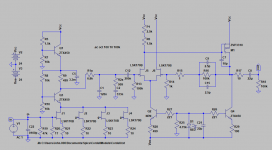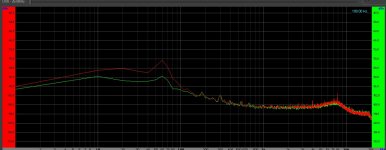Good Morning,
The Pearl pre-amp sounds great now with my Lx-mini active crossover. The bass frequencies are being boosted by the Pearl 2. I have tried adjusting the input resistors without luck. Any ideas on where to look if the bass frequencies are being boosted/high frequencies are being attenuated? Would the 5pF cap at C9 be a suspect? Does anyone have a full simulation file for the Pearl 2 that I could play with?
The Pearl pre-amp sounds great now with my Lx-mini active crossover. The bass frequencies are being boosted by the Pearl 2. I have tried adjusting the input resistors without luck. Any ideas on where to look if the bass frequencies are being boosted/high frequencies are being attenuated? Would the 5pF cap at C9 be a suspect? Does anyone have a full simulation file for the Pearl 2 that I could play with?
Good Morning,
Does anyone have a full simulation file for the Pearl 2 that I could play with?
Cal Poly SLO EE alum here... just had to toss that in based on your handle/location. 😎
I do have a simulation file I could provide, in Micro-Cap. Send me a PM if interested.
For some measurements you could look at post 1341 in this thread. With stock RIAA values the bass is boosted a bit, but only a few tenths of a dB, so probably barely audible.
Does anyone have a full simulation file for the Pearl 2 that I could play with?
Attached
Attachments
Last edited:
In the above, change Q2 from NPN to ZTX450. I modified the *.asc to include a behavioral voltage B1 with the RIAA time constants. This will save time for the analysis.
The ZVP3310 model is lashed up from ZVP3306 in Multisim which is quite similar, but there is no VDMOS model of either, so ymmv.
The ZVP3310 model is lashed up from ZVP3306 in Multisim which is quite similar, but there is no VDMOS model of either, so ymmv.
Pass DIY Addict
Joined 2000
Paid Member
I picked up a FocusRite 2i4 Gen 2 just a short while ago and connected it to the output of my Pearl 2 build. Before I go digging too far into things, is this a somewhat "normal" noise profile from the Pearl 2? This seems a bit high to me, especially in the 10Hz - 100Hz range (right channel is red, left channel is green). Seems like there is some difference between the two boards that I'm trying to track down. This graph is from the "max hold" setting of the software.
Both traces are from an outboard DC PSU connected by a 5-ft umbilical cord. I wanted to compare inboard vs outboard PSU configurations and noise performance.
Both traces are from an outboard DC PSU connected by a 5-ft umbilical cord. I wanted to compare inboard vs outboard PSU configurations and noise performance.
Attachments
I have seen posts regarding the possibility of an “overload” to Pearl 2 from high-output MM cartridges, as well as posts saying that shouldn’t happen. After experiencing some unnatural sounds during loud passages with my (possibly aging) Ortofon 2M Red (5.5 mV), I bought a Grado Opus3 low-output cart (1.0 mV). I just decided that given the gain from a standard Pearl 2, it was better to feed it a signal more in the range of an MC cart rather than fiddle with the Pearl 2 itself. (Yes, the cart is $275, but I was ready to upgrade anyway.) I have never since heard the same unpleasant sound. Just my experience. Very happy with the lineup now.
I have seen posts regarding the possibility of an “overload” to Pearl 2 from high-output MM cartridges, as well as posts saying that shouldn’t happen. After experiencing some unnatural sounds during loud passages with my (possibly aging) Ortofon 2M Red (5.5 mV), I bought a Grado Opus3 low-output cart (1.0 mV). I just decided that given the gain from a standard Pearl 2, it was better to feed it a signal more in the range of an MC cart rather than fiddle with the Pearl 2 itself. (Yes, the cart is $275, but I was ready to upgrade anyway.) I have never since heard the same unpleasant sound. Just my experience. Very happy with the lineup now.
The Grado's, being moving iron, need a lower value input resistor for correct damping. I believe that their website suggests 10k.
I pointed out the possibility of overload. You can always reduce the gain of the output stage.
Both traces are from an outboard DC PSU connected by a 5-ft umbilical cord. I wanted to compare inboard vs outboard PSU configurations and noise performance.
The umbilical is picking up the 60Hz mains "field" -- you could try shortening the power connection, and make sure that the chassis of the Pearl is connected to "earth" ground.
The Grado's, being moving iron, need a lower value input resistor for correct damping. I believe that their website suggests 10k
Thanks, I hadn’t noticed that. I’ll try 10K ohms and listen. I foresee moving to MC cartridges eventually and just decided to keep the output gain unchanged. Maybe I’ll add a resistance switch for MC levels when I try the 10K value.
By the way there is some good grounding and shielding advice in this thread: Shielding thoughts and looking for experience
I’d like to drive a modified Pass Lx-mini active crossover with the Pearl 2. The crossover’s input impedance will be 5k-6k ohms. I was going to use the simulation, but wanted someone opinion on whether there will be any issues.
Last edited:
There is no logical reason to skip having a linestage in-between the Pearl and the Xover. (If for no other reason then you'll need volume) Throw a BA2018 or something similar there.
My two TU-8600s have volume control. I’d prefer one less component in the audio chain if the input impedance of 5k-6kohms is not a problem.
I could also adjust the input impedance of the active crossovers if it is an issue.
I could also adjust the input impedance of the active crossovers if it is an issue.
Pass DIY Addict
Joined 2000
Paid Member
The umbilical is picking up the 60Hz mains "field" -- you could try shortening the power connection, and make sure that the chassis of the Pearl is connected to "earth" ground.
Thanks for insight and thread link! I was able to reduce the 60Hz-induced noise (was clearly seeing odd harmonics of AC hum: 60Hz primary, 180Hz, and 300Hz) by simply re-arranging the AC wires with respect to the DC umbilical. This lowered the noise floor to about -105dB across the spectrum. Still seeing about 5-10dB more noise in one channel than the other. I need to double check my wiring and solder joints between the boards.
Last edited:
It's a total system gain issue. The only gain you have will be in the Pearl, none in the crossover, which is all buffer, and the gain of the power amplifier. (The volume on the Elekit is just an input attenuator.)
It might work, particularly if you have very efficient speakers, and it's worth a try. The crossover input impedance won't be a problem.
But I wouldn't do it without a linestage...
It might work, particularly if you have very efficient speakers, and it's worth a try. The crossover input impedance won't be a problem.
But I wouldn't do it without a linestage...
Raw power supply board question
Could I use the power supply board from the store for this project...? Thanks
Could I use the power supply board from the store for this project...? Thanks
All you really need is something like this:
ELECTRONICS-SALON Dual Bridge Dual Polarity Unregulated Power Supply PCB. ELECTRONICS-SALON A-460, ELECTRONICS-SALON PCB-A460
ELECTRONICS-SALON Dual Bridge Dual Polarity Unregulated Power Supply PCB. ELECTRONICS-SALON A-460, ELECTRONICS-SALON PCB-A460
All you really need is something like this:
ELECTRONICS-SALON Dual Bridge Dual Polarity Unregulated Power Supply PCB. ELECTRONICS-SALON A-460, ELECTRONICS-SALON PCB-A460
Yep or even build the simpler one in the Pearl 2 doc from scratch.
- Home
- Amplifiers
- Pass Labs
- Building a Pearl 2

